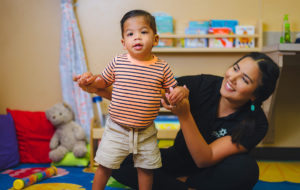What is Physical Therapy?
 Brighton Center physical therapists (PTs) provide physical therapy services with expertise in movement, motor development, and body function (eg, strength, coordination). Our San Antonio physical therapy team provides care that promotes active participation in daily routines (in home, in community and other relevant settings), optimizes movement and mobility, enables access to community programs, and supports family caregiving. Our pediatric physical therapy team also promotes health and wellness in collaboration with the child and family, medical providers, developmental and rehabilitation specialists, and educational providers.
Brighton Center physical therapists (PTs) provide physical therapy services with expertise in movement, motor development, and body function (eg, strength, coordination). Our San Antonio physical therapy team provides care that promotes active participation in daily routines (in home, in community and other relevant settings), optimizes movement and mobility, enables access to community programs, and supports family caregiving. Our pediatric physical therapy team also promotes health and wellness in collaboration with the child and family, medical providers, developmental and rehabilitation specialists, and educational providers.
How will a Brighton Physical Therapist Work With My Child
Pediatric physical therapy begins with an evaluation to determine areas of need and/or concerns. This determination is made through conversation with the family as well as by examination and evaluation of following:
- body structure/function (eg, muscle and joint function, sensory and neuromotor performance, posture),
- ability to perform specific activities (eg, balance and mobility),
- participation in various relevant and meaningful activities (eg, play with family and/or peers, participate in childhood games), and
- needs for assistive devices (eg, adaptive toys and/or equipment).
Once a pediatric physical therapist establishes a plan of care, which includes target outcomes as well as frequency of visits, Physical Therapy may take place. Our San Antonio Physical Therapy services may occur in a variety of settings including at home, at child care centers, and in the community. Each of activities are performed within the context of every day routines, using toys and other supports typically found within those settings. Because children learn through play, therapists embed interventions within play activities to optimize motivation, meaningful participation and joy. Furthermore, therapists may consider using assistive devices and/or toy and equipment adaptations/modifications. This can help optimize the child’s movement and their ability to participate in play or other activities.
How will a Brighton Physical Therapist Work With Me as a Parent/Caregiver?
Of utmost importance is the collaborative relationship between the Physical Therapist and parent(s)/caregiver(s) to facilitate child- and family-centered care. Visits are typically 45 minutes to 1 hour in length. During that time, a Pediatric Physical Therapist in San Antonio will plan activities jointly based on parent-identified needs/priorities and target outcomes. Then, the Pediatric Physical Therapist will practice Physical Therapy Activities with your child within usual routines. Moreover, the Physical Therapist will provide instruction and model activities for the parent(s)/caregiver(s). Afterwards, the Physical Therapist will facilitate parent(s)/caregiver(s) practice of the same activities. Discussion and feedback is shared with parent(s)/caregiver(s) throughout the visit. It is essential to equip children through use of play and participation in daily routines that addresses areas of need. Equally, it is essential to empower parent(s)/caregiver(s) with knowledge and skills to carry over strategies within those daily routines.
How do I know if my child might benefit from Pediatric Physical Therapy?
Babies develop at different paces based on so many different factors. One child learning to walk at 10 months and another at 13 months isn’t an indicator of a medical issue. Furthermore, these metrics won’t predict which baby is going to end up as a star athlete. But there does come a time for concern, and that’s when you should speak up to your child’s doctor. They can refer your child for Pediatric Physical Therapy Services evaluation by a pediatric physical therapist in San Antonio who has received special physical therapy training, like the ones at Brighton Center. On that note, here are six warning signs to look out for:
- Baby prefers to turn head only to one side
- Baby is not bearing weight on legs by 6 months
- Baby is not sitting by 8 months
- Baby is not crawling by 12 months
- Baby is not walking by 18 months
- Child only walks on tip toes for more than 6 months






